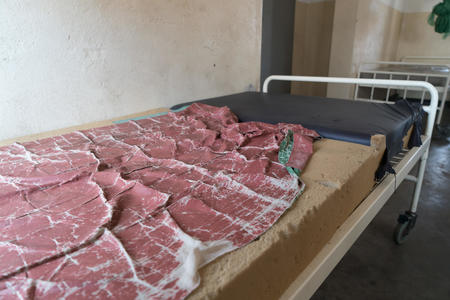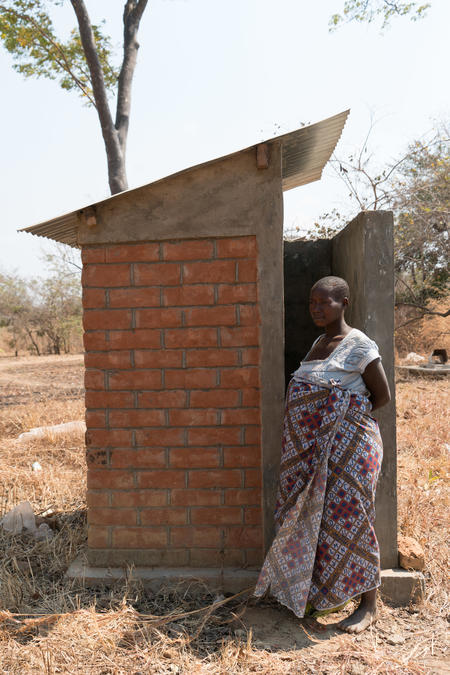No longer business as usual: Deliver Life project

In Malawi pregnant women face one of the world’s highest maternal mortality rates. Abigail Nyaka, Programme Officer for Soapbox at WaterAid Malawi, describes the context of Deliver Life – WaterAid’s project to bridge the gap between government efforts and improved maternal and newborn health with improved access to water, sanitation and hygiene.
When a life is brought into the world, there are ululations and jubilation. But sometimes the celebrations are curtailed by sudden silence and tears – when a mother or a baby dies during childbirth. The beginning of one life should not mean the end of another.
Mahmoud Fathalla, former president of the International Federation of Gynecology and Obstetrics, said: "Women are not dying of diseases we can’t treat…. they are dying because societies have yet to make the decision that their lives are worth saving". I ask myself – where does Malawi stand on this?
Globally, 830 women die every day1 from childbearing-related causes. Malawi has one of the world’s highest maternal mortality rates, at 460 per 100,000 livebirths.2 The causes include haemorrhage, hypertensive disorders, prolonged labour, unsafe abortion, and sepsis.
In Malawi, sepsis alone accounts for 17% of maternal deaths and 20% of neonatal deaths.3 Despite efforts by the Government siand various organisations working to reduce maternal and newborn mortality rates at different levels such as healthcare facilities and family and community levels, there is still a gap.
Most healthcare facilities here lack safe running water, supplies, and other basic hygiene facilities such as improved toilets and bath shelters. Where toilets are available they are often not designed to suit the needs of a pregnant woman. Having to use unsafe and unhygienic facilities with no privacy compromises the dignity and safety of women, putting them at risk of infection.
Deliver Life through improved WASH
WaterAid Malawi is implementing the Deliver Life project, funded with UK aid from the British people, which aims to improve access to, and use of, sustainable water, sanitation and hygiene (WASH) services in communities and health facilities in the marginalised districts of Kasungu, Nkhotakota, and Machinga. This project is a shift from business as usual because it integrates WASH in health outcomes, especially for mothers and babies, with the aim to ensure a safe and clean delivery environment and reduce the risks of WASH-related illnesses.
Since the problems are multifaceted and there is no single ingredient or magic bullet to improving maternal health, the project has four pillars, with integration being cross-cutting. We believe that WaterAid Malawi alone cannot curb the problem, so we have combined our efforts with those of other partners.
Sector strengthening is another pillar, looking at issues of WASH and maternal and newborn health policy integration, WASH and maternal and newborn health coordination mechanism strengthening, capacity-building in infection prevention, WASH monitoring systems, and dissemination of models of policy input.
A third pillar is service provision. Deliver Life is looking at provision of a solar-powered water supply system in 16 health facilities across the three districts, and in 16 villages around the targeted health facility catchment area. It aims to improve waste management within the health centres by providing incinerators, placenta pits, and well-lined waste pits, and encouraging infection prevention by providing clients with adequate bathrooms and toilets. The project also includes capacity-building of healthcare facilities on infection prevention.
In addition to this is the push for hygiene behaviour change around cleaning, disinfection, sterilisation, personal protective equipment, and surfaces such as bedrails and trays that are at risk of transmitting nosocomial infections. The project will also promote good sanitation and hygiene behavioural change in the villages surrounding the healthcare facilities.
Rights-holders not beneficiaries
The community being the critical driver of development in any good democracy, members will be involved, to ensure sustainability of interventions. The project seeks to change the perception of communities as beneficiaries to one of them as rights-holders with responsibilities, entitlements, and the capacity to change their situation. Under this fourth pillar – citizen empowerment – the project will work with communities, the media, parliamentarians, and many more individuals to strengthen accountability relationships between citizens and duty-bearers.
Through this initiative the project will also target women’s groups in order to build their capacity to lead discussion and take part in activities including lobbying and advocating for safe motherhood and newborn care. The project will also target male involvement so that men are committed to providing all the essentials for birth preparedness. Deliver Life is also targeting MPs and councillors to be champions in the promotion of maternal health, and healthcare facility advisory committees who will be strengthened to fulfil their role linking the community with service providers, to ensure grievances are properly addressed on both the demand and supply sides.
WaterAid Malawi's unique agenda
This work represents a new front for the Malawi County Programme in integrating its work and collaborating increasingly with the health sector. As a new player in the sector, WaterAid Malawi faces competition from well established WASH players – and Malawi’s health sector is a crowded space.
However, our agenda is unique in that it is bringing a greater focus on WASH within the healthcare system, which gives us the opportunity to influence the WASH sector. This opportunity comes with responsibility to ensure the quality of services and nurture collaborative relationships with other sector players, so as to maintain the added value of improved WASH as a critical component in health service provision. It promises to be an exciting journey and I am glad to be a part of it.
1. WHO 2016. World Health Organization fact sheet on maternal mortality, updated November 2016. Available atwww.who.int/mediacentre/factsheets/fs348/en (accessed 20 December 2016).
2. National Statistical Office (NSO) and ICF Macro (2011). Malawi Demographic and Health Survey 2010. Zomba, Malawi, and Calverton, Maryland, USA: NSO and ICF Macro. Available atwww.dhsprogram.com/pubs/pdf/FR247/FR247.pdf (accessed 20 December 2016).
3. Liu L, Oza S, Hogan D et al (2015). Global, regional, and national causes of child mortality in 2000–13, with projections to inform post-2015 priorities: an updated systematic analysis. Lancet 385: 430–440. doi: 10.1016/S0140-6736(14)6169.





